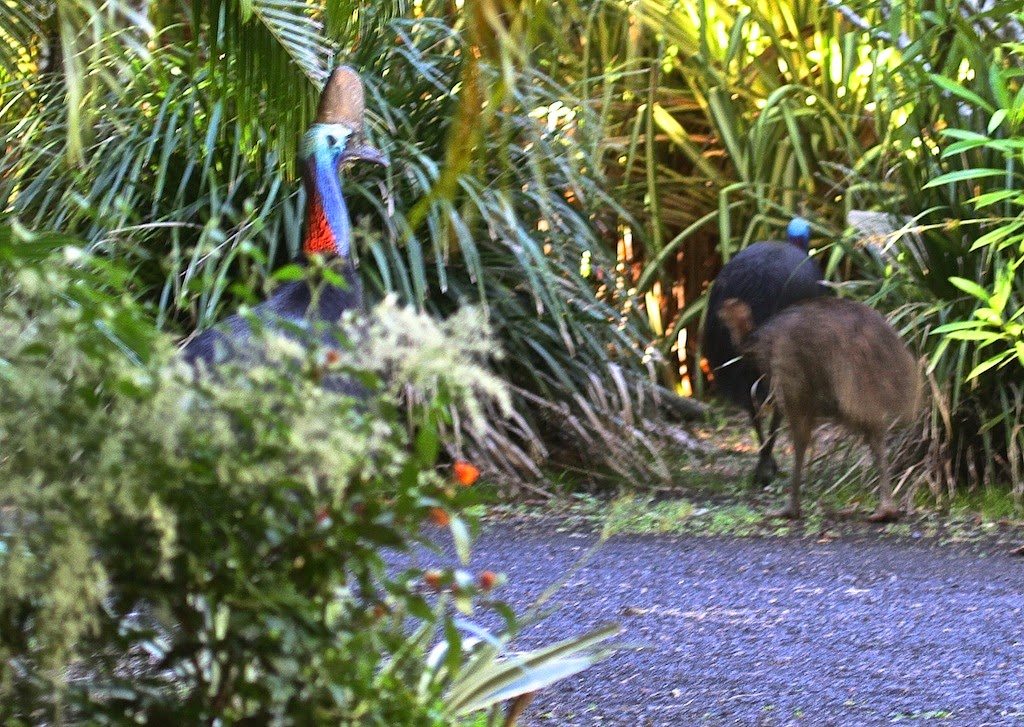It was so good on Wednesday morning to hear a grazier from Charleville report that he had received 14 mm of rain. Since then moderate rain has continued to fall, not only in Charleville but over much of the parched, drought declared lands of western Queensland and northern New South Wales.
Unfortunately, the wet weather is not so great for the sugar cane harvest along the coastal belt. While the cane sits in the sodden fields the sugar content falls and the mills undergo very costly stop-start procedures. The weather is predicted to be clearing and back to sunshine next week.

 When the rain stops for a few minutes it is surprising to see the instant activity of birds as they search for food.
When the rain stops for a few minutes it is surprising to see the instant activity of birds as they search for food.Dusky honeyeater manoeuvres with great dexterity around the flower spikes of this match-stick bromeliad as he extracts every drop of nectar from the flowers.

 Leaden flycatcher waits for the first break in the clouds to dash about the branches in search of insects.
Leaden flycatcher waits for the first break in the clouds to dash about the branches in search of insects.Nearby shining flycatcher appears to be intent in gaining the attention of his mate as he displays and chases her in and out of the low canopy of the mangrove trees. If you are lucky she will sit for a moment so you can admire her rich chestnut wings and tail feathers contrasting with her satin black head and pure white chest feathers. Then she darts off in search of an insect while ignoring him as he calls and displays close by.

.JPG)


Competing in the same mangrove habitat varied triller chooses from a wider culinary selection. She will eat insects, caterpillars and seeds, thus she is a very resilient little bird.


 Cassowary Snout and Queenie continue to meet almost daily and mostly without aggression. At five years old this is Queenie's first season and she hasn't as yet pushed the right buttons for Snout.
Cassowary Snout and Queenie continue to meet almost daily and mostly without aggression. At five years old this is Queenie's first season and she hasn't as yet pushed the right buttons for Snout. On Tuesday Snout was hanging about the nursery with Ky, unusual for him, then Queenie arrived to take a drink. When she saw Snout she stretched to full height.
On Tuesday Snout was hanging about the nursery with Ky, unusual for him, then Queenie arrived to take a drink. When she saw Snout she stretched to full height.Snout stood up but lowered his head as if in submission.

 Queenie approached Snout and he dropped his head in submission.
Queenie approached Snout and he dropped his head in submission.Then Snout, while looking back at Queenie, began to walk away.


As if sensing some danger to Ky Snout turned towards his chick.
He then turned, and started to walk out the gate with Queenie following. Little Ky uttered a low pathetic whistle and suddenly Snout sat down. Ky moved over to his dad and Queenie moved away.


Snout walked off with Queenie watching not sure what she was supposed to do.
Meanwhile old matriarch cassowary Jessie remains at the top of the Moresby Range hanging around in the vicinity of the two older males, Hero who is alone and Hagar with his chick Rainbow, no courtship happening there.
Matriarch cassowaries Peggy and Clara have not been sighted recently, nor have the male cassowaries Brown Cone, Stumpy, Don or Captain Starlight. No recent sightings of Dot or the two year old chick I saw last month or the old cassowary with the cracked casque that Pam B. saw.
I was told of two cassowaries around Clancy Park East Innisfail possibly courting but no photos as yet.

 There is plenty of food for the cassowaries around at the moment with Quandong, Elocarpus eumundi seen in almost all the scats. As well, pandanus fruits falling and Davidson plum, Davidsonia prurient ripe and starting to fall.
There is plenty of food for the cassowaries around at the moment with Quandong, Elocarpus eumundi seen in almost all the scats. As well, pandanus fruits falling and Davidson plum, Davidsonia prurient ripe and starting to fall.Another fruit which the cassowaries are eating at the moment, but I am not able to identify, see below, possibly a Sersalisia sp. Please let me know if you can identify this tree.


Ian Laidlaw on the Palmerston had a
little visitor to his farm this week, a Queensland tube-nosed bat. Ian rescued it from a barbed wire fence. Ian has noticed these little bats like to feed on fruits growing low to the ground or fruits that have fallen. The 'snorkel' nostrils are quite large vessels and when the animal is relaxed or flying the nostrils would collect large volumes of air and hence they have a very acute sense of smell.
Ian observed when the bats were feeding, the teeth of the bottom jaw pushed into the soft fruit, the top lip rolled up to prevent the puree from falling out and he thought perhaps that is when the snorkel nostril has another purpose in allowing the bat to breath.
Thank you Ian for saving this little creature and sharing your beautiful photos.
That's all for this week,
Cheers,
Yvonne







No comments:
Post a Comment